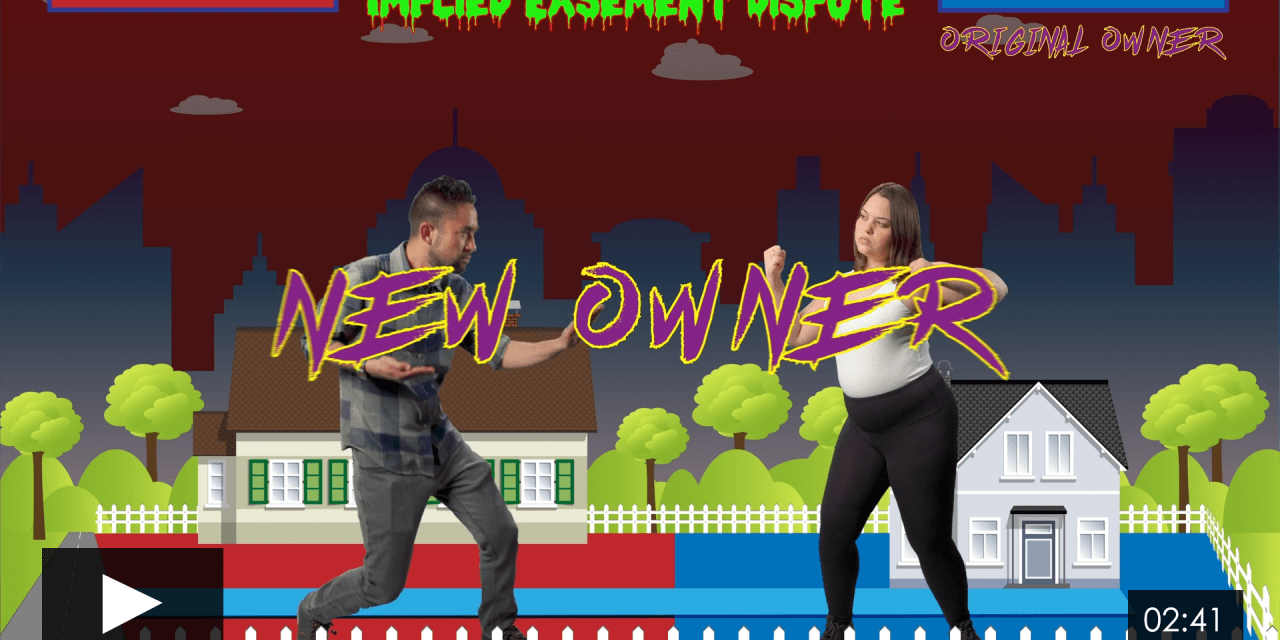This is the fourth episode in our new video series covering easements. The prior episode covers the written documents used to create an easement between benefitting and burdened properties.
This episode covers the requirements for establishing an implied easement without any prior agreement between the grantor and the grantee.
No prior agreement
An easement can be created by conduct without any prior agreement between the owner and the user, called an implied easement.
Implied easements exist when the circumstances surrounding an owner’s division of their property and sale of a portion of the property imply the owner (grantor) and the buyer (grantee) intended either:
- the grant of an easement on the portion retained by the owner; or
- the reservation of an easement by the owner on the portion sold. [ Civil Code §1104; Palvutzian v. Terkanian (1920) 47 CA 47]
The requirements for establishing an implied easement are:
- a prior common ownership of adjoining parcels;
- a transfer of one of the adjoining parcels;
- an obvious and apparent prior use of one parcel for the benefit of the other parcel during the period of common ownership; and
- a reasonable necessity for creating the easement. [Greene Fickert (1942) 49 CA2d 511]
Prior common ownership of parcels
A transfer of one of two or more adjoining parcels by a common owner is required to create an implied easement.
For example, an implied easement may arise when a co-ownership of a property is terminated and the property is divided and parceled out to the individuals who were the co-owners.
Additionally, an implied easement may arise on the distribution of property under a will or trust.
For example, a beneficiary receives a parcel of real estate which is accessible only by a road over an adjoining parcel conveyed to another beneficiary under a will or inter vivos (living) trust which does not provide for an easement.
In this scenario, a right-of-way easement is created by implication since the common ownership of the adjoining parcels is the estate or trust. [Cheda v. Bodkin (1916) 173 C 7]
Division by transfer
An owner of property who uses a portion of their property for the benefit of another portion of the same property does not create an easement on their own property.
An easement is a right to use another’s land or prevent another from a particular use of the owner’s land. Thus, an owner cannot hold an easement over their own land. [Calif. Civil Code §805]
Only the division of commonly owned parcels by the transfer of a parcel triggers the creation of an implied easement.
Beneficial use of commonly owned parcels
The prior use of one parcel for the benefit of an adjacent, commonly owned parcel needs to be obvious and permanent for the new owner on the transfer of one of the parcels to establish the right to an implied easement to use the other parcel.
To establish an implied easement, the prior use by the common owner needs to have been:
- either known to both the common owner (original grantor) and the buyer (grantee), or so obvious their knowledge may be presumed;
- regularly used during the common ownership before the transfer; and
- intended to be permanent.
The purpose for creating an implied easement is to establish the right to continue an existing use a buyer and seller intend to permanently maintain, but fail to mention.
Thus, an implied easement is not created when the common owner of adjacent parcels and the buyer of one parcel do not intend for an easement to exist on the adjoining parcels.
For example, a subdivider sells a parcel. The subdivider retains an adjacent parcel which has a heating plant with heat and water pipes running to the parcel sold.
At the time of the sale, the subdivider and the buyer enter into a service agreement providing for the buyer to receive the heat and water in exchange for payment of a service fee.
Later, the subdivider refuses to allow the buyer the continued use of the heat and water pipes on the subdivider’s property.
The buyer seeks to establish an easement for the use of the pipes claiming an implied easement was created on the transfer of the parcel to the buyer by the subdivider.
Has an implied easement been created?
No! Although the criteria for an implied easement appears to be present, the written agreement charging a fee for the use of the pipes between the subdivider and buyer indicates the permanent benefits of an implied easement appurtenant to the property sold were not intended. [Warfield v. Basich (1958) 161 CA2d 493]
Reasonable necessity
For an implied easement to exist, the easement must be reasonably necessary for the beneficial use of the parcel whose owner is seeking to establish the easement.
Consider an owner who sells and conveys a parcel containing a driveway. The owner uses the driveway to access an adjoining parcel they own which is improved by their residence. The owner does not reserve an easement for use of the driveway in the conveyance to the buyer.
The owner’s residence fronts on a public road. The driveway through the buyer’s parcel is the only improved access to the owner’s home. The cost of building a road for access to the public road is a reasonable amount for the value of the residence.
On closing, the buyer refuses to allow the owner to use the driveway over the parcel sold to the buyer.
The owner claims they are entitled to an implied easement over the parcel sold to the buyer since, prior to the sale, the driveway provided access to the adjoining property they retained.
The buyer claims the owner is not entitled to an implied easement since they can build a new driveway to the public road.
Is the owner entitled to an implied easement to use the buyer’s driveway?
No! An implied easement (by reservation) is not reasonably necessary to the owner’s beneficial use of the adjacent property they retained since the owner can build a new driveway to the public road at a reasonable cost. [Leonard v. Haydon (1980) 110 CA3d 263]
Thus, an implied easement is created for the benefit of property only when a reasonably convenient alternative is not available to the property and a reasonable necessity for the easement exists.
Implied grant vs. implied reservation
Although California codes only refer to implied grants of an easement by the owner of the burdened property, case law has established an implied reservation of an easement on property sold. [CC §1104]
For instance, a seller maintains irrigation ditches to control the flow of water on two adjoining parcels of real estate they own and operate for agricultural purposes.
The seller conveys the parcel containing the water source to an investor and the adjoining parcel to a farmer. The deeds do not make mention of irrigation or water easements.
The investor eliminates the irrigation ditches on their property, blocking the farmer’s only access to the source of their water.
The farmer claims they have an implied easement for the use of the irrigation ditches for the flow of water.
Is the farmer entitled to an implied easement over property conveyed to the investor under a deed which does not reference an irrigation or water easement?
Yes! An implied reservation is created as though the easement had been reserved by the seller in the grant deed to the investor. The seller’s pre-existing use of the irrigation ditches on the property acquired by the investor is apparent, and the ditches were constructed to be permanent and are the only source of water to the parcel acquired by the farmer. [Palvutzian v. Terkanian (1920) 47 CA 47]
Thus, the same criteria are used to establish an implied easement by either grant or reservation.
However, when a buyer does not have knowledge of the previous use of a parcel of real estate from the county records, or the existing use is not obvious on an inspection of the property, the buyer is considered a bona fide purchaser (BFP) and takes title to the property without the easement.
Implied easement by reference to map
When a landowner records a subdivision map and offers to dedicate the roadways depicted on the map to a public use, a public easement is created on the government’s acceptance of the right of ways legally described on the subdivision map. [Calif. Government Code §§66410 et seq.]
Similarly, when a recorded subdivision map lays out acreage into parcels and streets and sells the lots by reference to the subdivision map, the buyers of the lots have easements in the streets adjoining their lots. [Danielson v. Sykes (1910) 157 C 686]
An easement implied is another’s appurtenance
Regardless of how an implied easement is created, it is always a burden on one parcel of land for the benefit of another parcel.
Thus, an implied easement is always an appurtenance allowing the owner of the property benefitting from the easement to use the property of another which is burdened by the easement.
Most disputes over implied easements occur after the property burdened by the easement has been deeded out to new owners.















My church has a parking lot in the back of our building that the church owns. The owner of the house has a side gate in his back yard to have access to his back yard for parking of a boat that he uses on the weekends. The church keeps the parking lot locked, so that cars aren’t parked there, when church is not in attendance. If we give the combination to the locks to the neighbor so that he can get his boat out of his backyard to the street, have we created an implied easement or any other kind of easement?